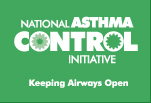Michigan Department of Community Health
"…We're developing some simple tools and activities that primary care practices can use to help to incorporate asthma guidelines into their primary care.”
Sarah Lyon-Callo, M.A., M.S., Asthma Investigator, Michigan Department of Community Health
Sarah Lyon-Callo, M.A., M.S., Michigan Department of Community Health, uses the NACI's network to share tools and best practices with other communities across the country.
Project Snapshot
The Michigan Department of Community Health (MDCH) Asthma Prevention and Control Program worked to make the Expert Panel Report 3–Guidelines for the Diagnosis and Management of Asthma (EPR-3) easier for clinicians to use in Michigan through a program called the Asthma Guideline Implementation Steps and Tools (GIST).
In collaboration with the Asthma Initiative of Michigan (AIM), MDCH developed simple tools and redesign measures to help clinicians and health care providers incorporate all six of the key messages of the Guidelines Implementation Panel (GIP) Report into their everyday practice. MDCH piloted the GIST tools in two practices and evaluated for impact on asthma action plans, asthma control assessment, and inhaled corticosteroid prescriptions.
Project Goals
- Increase guideline-based asthma care given by providers using simple tools and practice-level system support.
- Test GIST tools in pilot practices.
- Distribute GIST tools to Michigan primary care practices.

Sarah Lyon-Callo leads a group discussion at a NACI meeting in Baltimore, MD.
Challenges & Solutions
Challenge: Increasing the use of asthma action plans (AAP) by practices. Although the GIST tools do not specify a particular AAP format, they do support the use of written AAPs in clinical practice. Both GIST pilot sites had challenges in their efforts to increase the use of AAPs. Despite its early success in adopting the GIST tools, one practice identified major barriers in its use of AAPs due to 1) lack of time in routine office visits and 2) lack of authority to change the peak flow based AAP in its electronic medical record (EMR), which many patients could not use because they did not know their peak flow numbers. The other practice also embraced the GIST tools and added them to its EMR, however, EMR software problems and difficulty in consistently using AAPs hampered progress in this area.
Solution: Develop individualized solutions that address identified barriers to AAP implementation. Because the two GIST pilot practices differed substantially in their structure and procedures, the GIST project team teamed with each practice to develop tailored approaches. At the first site, MDCH worked with its asthma champion to identify who could make changes to the AAP in the EMR and then initiated contact with that individual. It also met with additional physicians to learn more about the practice’s EMR system and culture of change. At the second site, GIST observed a discussion detailing how staff throughout the practice used the GIST tools. This feedback helped define new office procedures and redesign patient flow to help make AAPs a routine part of that practice’s asthma care.

Sarah Lyon-Callo and colleagues discuss NACI tools at a 2010 NACI meeting in Baltimore, MD.
Highlights
MDCH used lessons learned from its two pilot sites to develop an implementation guide to make the adoption and use of GIST tools in other real-world practices easier and more effective.
MDCH posted the GIST tools and implementation guide on the Asthma Initiative of Michigan Web site. GIST tools include Questions About Your Breathing (a patient/parent questionnaire), Asthma Diagnosis Tool, Asthma Patient Follow-Up Tool, and Stepwise Approach to Managing Asthma.
Synergies
MDCH shared and collaborated with additional NACI-funded projects to advance asthma care best practices. For example:
MDCH encouraged providers to participate in the six-month Spirometry 360 training program conducted by the University of Washington, a NACI Strategic Partner. One of MDHC’s partners, the University of Michigan Health System, received a scholarship to participate in the program.
The Clinical Asthma Champions Leadership Training conducted by the South Bronx Asthma Partnership/Bronx-Lebanon Hospital, a NACI Clinical Champion, has accepted six Michigan physicians into its program. One of these physicians is a current GIST asthma champion, and two others have expressed interest in using GIST in their practices.
To meet its project goals, MDCH focused on practice redesign for primary care providers.
Other NACI-funded projects that used MDCH-type approaches are:
Michigan Department of Community Health![]()
Asthma Prevention and Control Program
201 Townsend Street, 4th Floor, PO Box 30195
Lansing, Michigan 48909

















 Twitter
Twitter
 Facebook
Facebook YouTube
YouTube